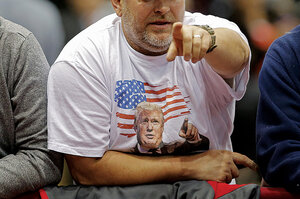A race that's about to get real
Every election year, a lot of American voters want to shake things up. The quadrennial question is whether "a lot" can carry the day.

A DONALD TRUMP SUPPORTER AWAITED HIS CANDIDATE AT A JAN. 8 CAMPAIGN EVENT IN ROCK HILL, S.C.
CHRIS KEANE/REUTERS
If you have tuned into the American presidential race over the past six or eight months, you know that a lot of voters are fed up with politics as usual. They feel the country is on the wrong track and that it’s time to rein in bureaucrats, fat cats, welfare cheats, the political correctness police, the mainstream media, and, while we’re at it, those ubiquitous Kardashians. Other worries: immigration, terrorism, crime, guns, lobbyists, and the economy. Plus the United States gets no respect.
A lot of people are telling reporters and pollsters they’re ready for an outsider, somebody who tells it like it is. Enter Donald Trump. Along with Bernie Sanders, Mr. Trump and his improbable candidacy have been the story of campaign 2016 so far. But the key to whether that story continues is whether “a lot of people” – a plurality in a multi-candidate race – can become a majority of the Republican primary delegates and, even harder, capture the presidency.
In a Monitor cover story (click here), Linda Feldmann, chronicling her sixth presidential race, assesses the Trump effect, what’s behind it and how it might play out in 2016 even if Trump’s quest for the White House doesn’t. Trump has stirred up the race by courting controversy and tapping into the free-floating angst described above. He’s an unapologetic tycoon who talks like a populist, a front-runner with vague policies and a party-hopping past, a showman who insults everyone but also seems kiddable. His gold-encrusted habitats, engineered hair, TV celebrity, and roller-coaster business and love lives have been in the public eye for more than a quarter of a century.
If The Donald’s style is sui generis, he is nevertheless playing a stock character in the year’s presidential race. He’s the outsider. Herman Cain, Ralph Nader, Pat Buchanan, H. Ross Perot, John Anderson, and George Wallace all played that role at one time or another. An enduring slice of the American electorate loves the idea of sending a human wrecking ball to Washington. Dark horses, insurgents, and third-party candidates make life interesting.
For a while. Then voting begins. February’s caucuses and primaries in Iowa, New Hampshire, South Carolina, and Nevada set the stage for the big shows in March. By then the field will have narrowed, campaigns will be battle tested, and winners and losers will become clearer. War rooms, spin doctors, and get-out-the-vote efforts are now all-important. And voters will be looking for a candidate who isn’t just interesting and fun but can win in November.
Trump has money. He knows how to make headlines. He’s tapping into the zeitgeist, a lot of it. But is a lot a majority? The art of the deal is meaningless if the deal can’t be closed.

